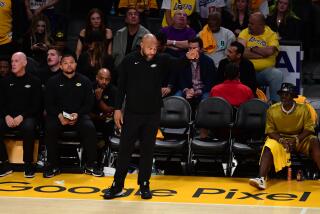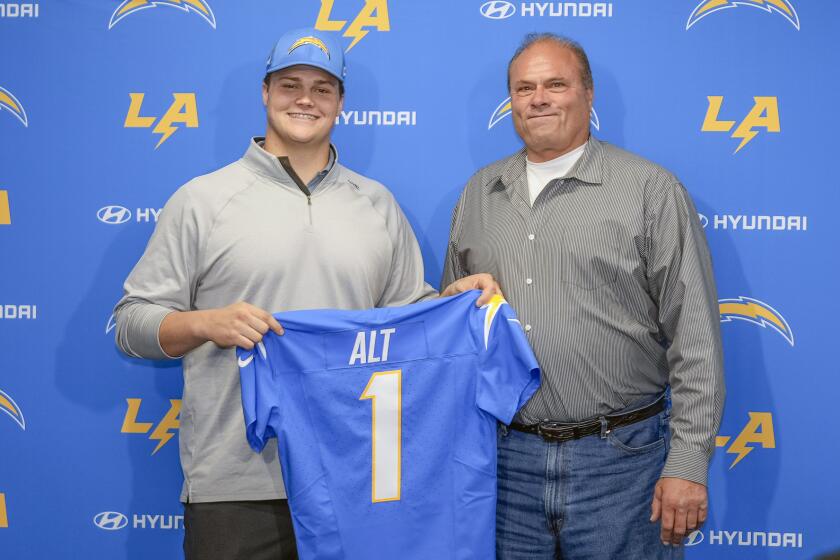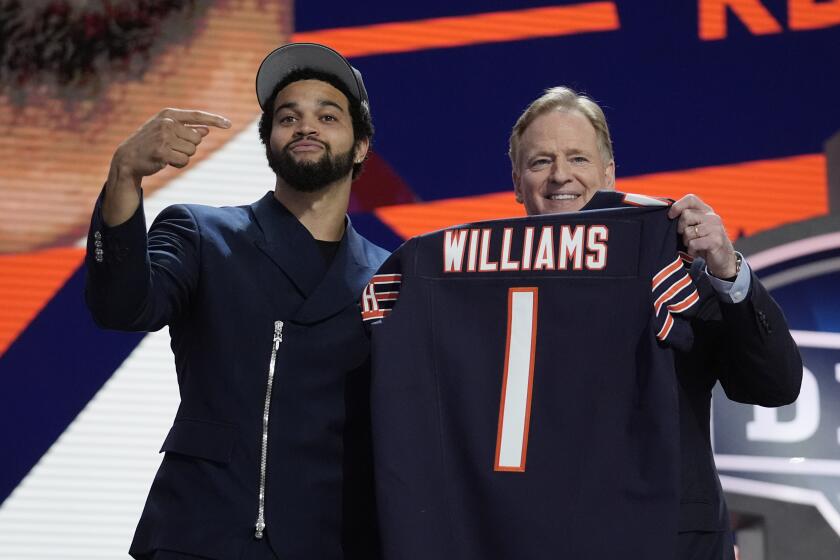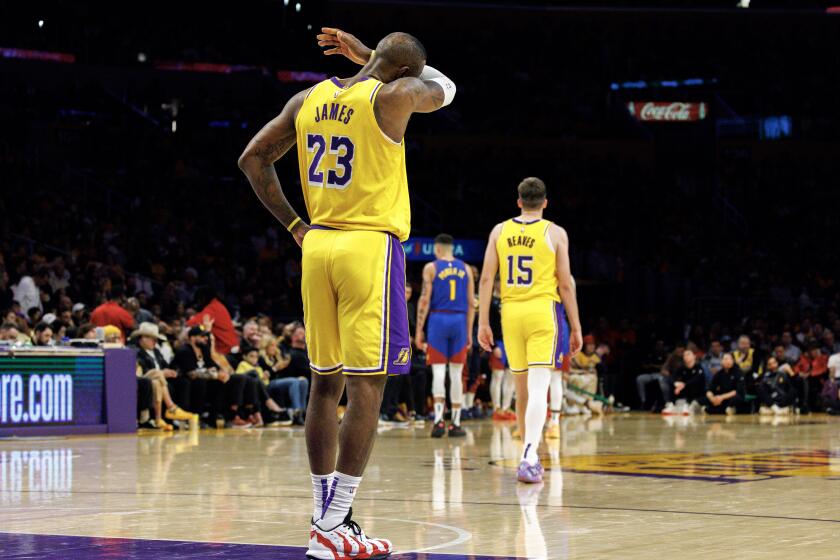Training Daze
EDITOR’S NOTE
Shav Glick is 82 years old, has been a sportswriter in Southern California since 1937 and an avid sports fan since before he was a teenager. He joined the old L.A. Mirror in 1954 and moved to The Times in 1961. These days, he covers auto racing for The Times, among other things, and has managed to cut his work week back to about 55 hours.
He writes here about the good old days of spring training, when some of the teams trained in Southern California.
“In those days, the only play-by-play you could find was done by the sportswriters,” Glick recalled. “I remember as a young sportswriter, sitting next to Hall of Fame Chicago writer Jim Enright, watching him work. A batter walked and Enright wrote, ‘Joe Smith strolled ... ‘ I never forgot that.”
*
Spring training in Pasadena in the 1930s and 1940s meant the White Sox were coming to town, staying at the quiet Maryland Hotel or the stately Hotel Green in the middle of town and training at Brookside Park.
For 10 years, from 1933 to 1942, it was a bonanza for baseball fans, young and old, who sat in the sun at Brookside -- now Jackie Robinson Memorial Field -- and traded good-natured barbs with the Chicago players.
It was an even more exciting time for a 14-year-old fan who could ride his bicycle to the hotel and sit in the lobby, chatting with Hall of Fame players such as Luke Appling, Ted Lyons and Al Simmons, asking them questions as if he were a big-time interviewer.
In 1935, there was little else for ballplayers to do in Pasadena -- no TV, no freeway to Los Angeles, no computers, no nothing much -- but lounge around the hotel, and that was just the way Jimmy Dykes, the crusty manager of the White Sox, wanted it.
Dykes spoke to a student assembly at Pasadena Junior College one day, and noting all the cars parked on or near the campus, said, “One of the problems with society is that everyone is getting soft. Why are all these young people riding to school? Why don’t they walk, or ride a bicycle? It’s going to be the ruination of society. Lazy, that’s what it is.”
Not surprisingly, Dykes had his players walk the two miles from the hotel to the practice field. He did let them ride back, however.
Many, notably big first baseman Zeke Bonura, wore rubber jackets during the walk to sweat off the pounds they had gathered during the off-season. Players showed up at spring training to get in shape, as opposed to today’s practice of arriving already in playing condition.
Dykes also had a rule that if players weren’t in the hotel dining room before 9 a.m., they had to pay for breakfast. Practice started at 11, giving them plenty of time for their stroll to Brookside.
The atmosphere in the ‘30s was a lazy one, players playing pepper along the sidelines, leisurely taking batting practice, playing catch or jogging around the outfield while a grandstand of mostly old-timers, unemployed because of the Great Depression, cheered and jeered their actions.
The Los Angeles Angels of the Pacific Coast League, who held territorial rights in the area, tried one spring to prevent the White Sox and Chicago Cubs from playing within 10 miles of L.A.’s Wrigley Field because of a lackadaisical attitude they felt hurt baseball’s reputation.
Angel management based its decision on “the willingness of both clubs to play ragged ball before they are fit and call themselves major leaguers.”
In an era of playing managers, Dykes was also the third baseman for the White Sox, having come from the champion Philadelphia A’s in a blockbuster trade with Simmons and Haas. In 1933, his first year with the White Sox, he had been the American League third baseman in the first All-Star game.
Dykes, who loved to chew on cigars when he wasn’t in the field, was a favorite target for the bleacher bums. A stubby 5 feet 9 and a bit on the paunchy side, he looked as if he belonged in the dugout, not on the hot corner, but when the fans bugged him for being overweight, he loved to cackle back at them. He was also one of the game’s great bench jockeys, constantly jabbing at the umpire and rival players.
Lou Comiskey, much overweight son of original owner Charles Comiskey, was a familiar figure at Brookside as he wandered around the field in a white suit, usually smoking Turkish cigarettes and munching on macaroons.
Southern California had been a favorite training site for major league teams as far back as 1908, when the White Sox worked out in Los Angeles, and 1911, when the Boston Red Sox trained in Redondo Beach. The Cubs were a fixture on Catalina Island -- which was owned by the Wrigley family, who also owned the Cubs -- for 21 years, from 1922 to 1942.
Other teams that came West included the Philadelphia A’s, with Connie Mack as manager, in Anaheim for three years, 1940-42; the Pittsburgh Pirates, in Paso Robles from 1924-34 and San Bernardino, with Hall of Famers Honus Wagner as coach and Pie Traynor as manager, from time to time between 1935 and 1952; and the St. Louis Browns, in Anaheim, Burbank and San Bernardino from 1940 to 1953.
Players had colorful nicknames in those days. The 1935 White Sox roster had “Old Folks” Appling, “Toots” Tietje, “Bullfrog” Dietrich, “Sad Sam” Jones, “Mule” Haas, “Rip” Radcliff and “Zeke” Bonura, whose real name was Henry John.
Where have all the nicknames gone? Political correctness has wiped out many. For instance, no one today would shout, “Go get it, Dago,” to Joe DiMaggio or Frankie Crosetti as they did in the ‘30s and ‘40s when it was considered a term of affection, not an ethnic slur. Nor would a Native American pitcher named Charles Albert Bender be called “Chief.”
It was a white-only society in baseball then too.
There were some eyebrows raised around baseball circles when the White Sox agreed to play an exhibition game with a Pasadena youth all-star team to raise money for the city’s Department of Recreation baseball school. The all-stars had two black players, Jackie Robinson at shortstop and Nate Moreland, one of the catchers.
A good trivia question, or a sports bar bet, is “When did Jackie Robinson first face major league pitching?”
Not 1946, when he played for the Montreal Royals, nor 1947 when he first wore a Brooklyn Dodger uniform. It was March 14, 1938, when he singled twice against rookie pitchers George Gick and Bob Uhle and stole his first base off a major league catcher in a game at Brookside Park.
“If that boy out there at shortstop was white, I’d sign him up right here, right now,” said Dykes, who managed for 21 years in the major leagues.
It would be seven years before Branch Rickey signed the Pasadena product as major league baseball’s first black player.
More to Read
Get our high school sports newsletter
Prep Rally is devoted to the SoCal high school sports experience, bringing you scores, stories and a behind-the-scenes look at what makes prep sports so popular.
You may occasionally receive promotional content from the Los Angeles Times.






